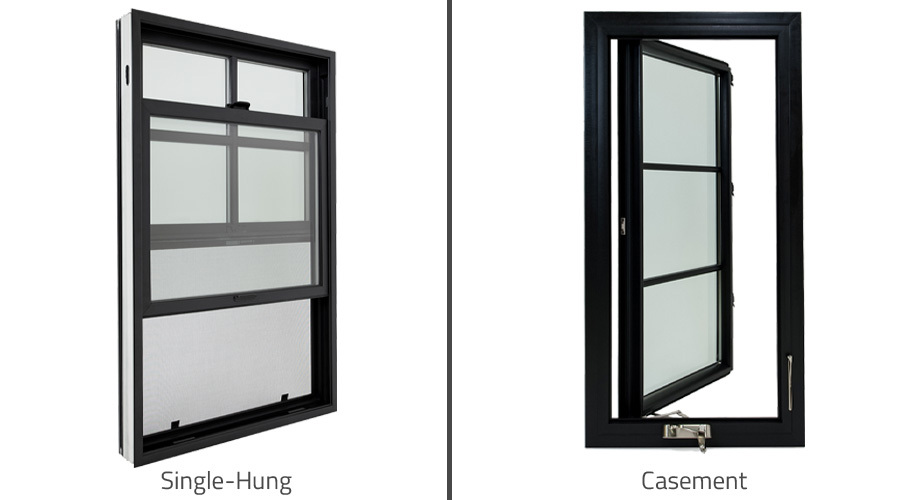
Are Single-Hung Windows More Efficient Than Casement Windows?
Single-hung windows and casement windows share some similarities but they also have many differences. In this post, we'll highlight some of the differences and discuss how that impacts the efficiency of single-hung and casement windows.
Use the links below to skip ahead:
- Single-Hung vs Casement Windows
- Are Single-Hung Windows More Energy-Efficient Than Casement Windows?
- Should I Get Single-Hung Windows or Casement Windows?
- Pros and Cons of Single-Hung Windows
- Pros and Cons of Casement Windows
Single-hung windows vs casement windows

Single-hung windows are vertically oriented and have two sashes in the window frame. The sash is the part of the window that holds the glass. In this window style, the top sash is fixed and the lower sash is operable meaning that the top sash doesn't move and the bottom one does.
Casement windows are also vertically oriented, however, casement style windows typically only have one sash in the window frame. Unlike single-hung windows, which slide in the jamb of the window, casement windows are held in the frame by a set of hinges. When you unlock the window, you can use a crank to push it open, or do it manually, depending upon its design. Casements can be hinged from the left or right side of the window.
Are single-hung windows more energy-efficient than casement windows?
The short answer is no, single-hung windows are not more energy-efficient than casement windows.
The reason for this comes down to the way that they open, close, and seal. A casement window is more energy-efficient than a single-hung window because of its design. The casement window sash has a seal around the perimeter that nests against the window frame, the lock on this window pulls the sash tightly against the frame creating a weathertight seal that you won't find on hung or sliding windows. When a single-hung window is closed and locked, the window can't be opened but there are plenty of opportunities for air to sneak in around the perimeter of the operable sash.
Fortunately, air leakage isn't the only factor that affects window energy-efficiency. Window manufacturers offer additional options and customization packages that allow you to create a more energy-efficient window no matter the style. These options are especially handy with less energy-efficient window styles. If efficiency is a major concern then you should also be mindful of your choices in window frame material and glass package.
Should I get single-hung windows or casement windows?
Determining whether you should get single-hung windows or casement windows is primarily down to your priorities. It also depends on how you would like to have your window open and if a window that swings outward would cause a dangerous obstruction in the area, you are installing. Here are some of the pros and cons of each to consider before making the final decision.
Pros and Cons of Single-hung windows
- Versatile window style fits in most home designs
- Easy to clean from inside if it includes a tilt-sash
- Screens are an easy and unobtrusive addition
- Flat profile prevents them from being a potentially dangerous obstruction to walkways
- Suitable options for any budget
- Highly customizable
- Less energy-efficient design than casement style
- Doesn't allow as much airflow as casement style when open
- Sleek design is perfect in contemporary homes
- Energy-efficient design
- Easy to open
- Full height sash opens allowing top to bottom ventilation
- Cranks can take more maintenance
- Difficult to add screens
- More expensive option
- Can obstruct walkways when open
Deciding on the best kind of window often comes down to the amount of money you want to spend now to invest in your home's future energy-efficiency. Although both of these options contain their positive and negative aspects, a casement window is a more energy-efficient option for your home.
News, Product Reviews, and Insights
Oops!
We don't currently serve your area but do want to help you plan your project. Try our Build & Price tool to get an idea of window & door costs within DFW. Your area may be higher or lower but at least you'll have some idea of the price.
Thanks for stopping by.




